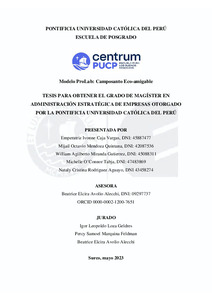| dc.contributor.advisor | Avolio Alecchi, Beatrice Elcira | |
| dc.contributor.author | Caja Vargas, Emperatriz Ivonne | |
| dc.contributor.author | Mendoza Quintana, Mijail Octavio | |
| dc.contributor.author | Miranda Gutierrez, William Agilberto | |
| dc.contributor.author | O’Connor Tabja, Michelle | |
| dc.contributor.author | Rodriguez Aguayo, Nataly Cristina | |
| dc.date.accessioned | 2023-05-22T21:29:00Z | |
| dc.date.available | 2023-05-22T21:29:00Z | |
| dc.date.created | 2023 | |
| dc.date.issued | 2023-05-22 | |
| dc.identifier.uri | http://hdl.handle.net/20.500.12404/25010 | |
| dc.description.abstract | El presente modelo de negocio aborda una alternativa de solución sostenible frente a
los problemas que afectan a toda la sociedad y que están contemplados en los siguientes
Objetivos de Desarrollo Sostenibles: de salud y bienestar (ODS 3), agua limpia y
saneamiento (ODS 6), ciudades y comunidades sostenibles (ODS 11) y finalmente la acción
por el clima (ODS 13). Por otra parte, en el Perú existe un grave problema de informalidad en
los cementerios, solo 16 de los 2,371 identificados cumplían con las exigencias de la Ley
26298 en el 2015. Además, difiriendo de lo que se piensa frecuentemente, el cuerpo de un
cadáver no es abono para el suelo, por el contrario, el cuerpo de un adulto de 70 kilogramos
genera 40 litros de lixiviados, y en caso este sea incinerado se emite a la atmósfera 400
kilogramos de dióxido de carbono.
En relación con lo indicado, proponemos un camposanto ecológico integral exclusivo
para cremaciones como solución a los problemas descritos. Son opciones funerarias que
dejan una menor huella ecológica, debido a la utilización de tecnología verde, como el uso de
hornos de cremación más modernos (Matthews) y carrozas eléctricas. Otro punto importante,
es que este camposanto está enfocado únicamente a la contratación de espacios cinerarios
haciendo un mejor uso de las tierras y no depredarlas como es usual en las sepulturas
tradicionales.
Esta propuesta resulta rentable al ofrecer servicios integrales (cremaciones, cinerarios
y servicios funerarios), lo que permite recuperar la inversión inicial en un periodo de 1.4
años. Finalmente, luego de realizar el análisis financiero se concluye que esta idea es
redituable debido a que los beneficios esperados permiten cubrir los costos fijos y variables,
logrando obtener un VAN financiero de 1’633,962 USD y un VAN Social de 2’135,378
USD. | es_ES |
| dc.description.abstract | This business model addresses an alternative for a sustainable solution to the
problems that affect the whole of society shown in the following Sustainable Development
Goals: health and well-being (SDG 3), clean water and sanitation (SDG 6), sustainable cities
and communities (SDG 11) and finally climate action (SDG 13). Also, there is a severe
problem of informality in cemeteries in Peru. Only 16 of the 2,371 identified complied with
the requirements of Law 26298 in 2015. Furthermore, differing from a common thought, the
body of a corpse is not soil. On the contrary, the body of an adult weighing 70 kilograms
generates 40 liters of leachate, and a cremation produce about 400 kilograms of carbon
dioxide emitted into the atmosphere.
Concerning the above, as a solution to the stated problems, we propose a
comprehensive ecological cemetery exclusively for cremations. They are funeral options that
make a smaller carbon footprint, thanks to green technology, such as more modern cremation
ovens (Matthews) and electric floats. Another relevant point is that this cemetery is focused
solely on hiring cinerary spaces, making better use of the land, and not preying on it as is
usual in traditional burials.
This proposal is profitable by offering comprehensive services (funeral services,
cremations, and itineraries), which allows the recovery of the initial investment in 1.4 years.
Finally, after carrying out the financial analysis, it is concluded that this idea is profitable
because the expected benefits allow for covering the fixed and variable costs, obtaining a
financial NPV of 1’633,962 USD and a Social NPV of 2’135,378 USD. | es_ES |
| dc.language.iso | spa | es_ES |
| dc.publisher | Pontificia Universidad Católica del Perú | es_ES |
| dc.rights | info:eu-repo/semantics/closedAccess | es_ES |
| dc.subject | Negocios--Planificación | es_ES |
| dc.subject | Desarrollo sostenible | es_ES |
| dc.subject | Cementerios--Perú | es_ES |
| dc.subject | Ritos y ceremonias fúnebres--Perú | es_ES |
| dc.title | Modelo prolab: Camposanto eco-amigable | es_ES |
| dc.type | info:eu-repo/semantics/masterThesis | es_ES |
| thesis.degree.name | Maestro en Administración Estratégica de Empresas | es_ES |
| thesis.degree.level | Maestría | es_ES |
| thesis.degree.grantor | Pontificia Universidad Católica del Perú. CENTRUM | es_ES |
| thesis.degree.discipline | Administración Estratégica de Empresas | es_ES |
| renati.advisor.dni | 09297737 | |
| renati.advisor.orcid | https://orcid.org/0000-0002-1200-7651 | es_ES |
| renati.author.dni | 45887477 | |
| renati.author.dni | 42087536 | |
| renati.author.dni | 45088311 | |
| renati.author.dni | 47483869 | |
| renati.author.dni | 43458274 | |
| renati.discipline | 413307 | es_ES |
| renati.juror | Igor Leopoldo Loza Geldres | es_ES |
| renati.juror | Percy Samoel Marquina Feldman | es_ES |
| renati.juror | Beatrice Elcira Avolio Alecchi | es_ES |
| renati.level | https://purl.org/pe-repo/renati/level#maestro | es_ES |
| renati.type | https://purl.org/pe-repo/renati/type#tesis | es_ES |
| dc.publisher.country | PE | es_ES |
| dc.subject.ocde | https://purl.org/pe-repo/ocde/ford#5.02.04 | es_ES |






